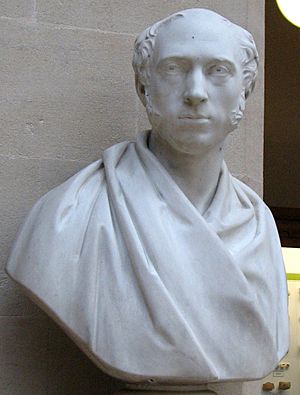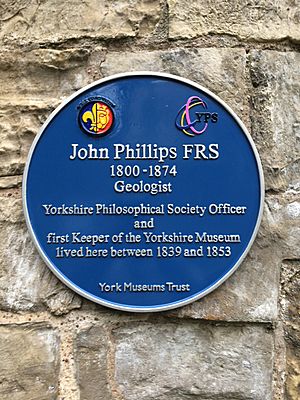John Phillips (geologist) facts for kids
John Phillips (born December 25, 1800 – died April 24, 1874) was an English geologist. He is famous for creating the first global geologic time scale in 1841. This scale helped scientists around the world agree on how to talk about different periods in Earth's history, based on fossils found in rocks. He even invented the term Mesozoic!
Contents
John Phillips: A Life in Geology
John Phillips was born in Marden, a town in Wiltshire, England. His father was from an old Welsh family. After his parents passed away when he was young, John was raised by his uncle, William Smith. William Smith was a very famous geologist himself.
In 1815, John moved into his uncle's home in London. For several years, he went to school and helped his uncle with his geology research and writing. John also became interested in lithography, which is a way of printing using stone slabs. He was one of the first people in England to try this method.
After finishing school, John traveled with his uncle William as he worked on geological maps. In 1824, they went to York where William gave lectures on geology. John started giving his own lectures and helping to organize museums in towns across Yorkshire. York became his home. In 1826, he became the keeper of the Yorkshire Museum and secretary of the Yorkshire Philosophical Society.
John's work grew beyond Yorkshire. By 1831, he was also working at University College London. That same year, the British Association for the Advancement of Science was started in York, and John was one of the people who helped organize it. He became the first assistant secretary in 1832 and held that job until 1859. In 1834, he also became a geology professor at King's College London, but he kept his job in York.
Important Discoveries and Roles
In 1834, John Phillips was chosen as a Fellow of the Royal Society, which is a big honor for scientists. He also received special degrees from universities like Dublin, Cambridge, and Oxford. In 1845, he won the Wollaston Medal from the Geological Society of London, another important award.
In 1840, John left his job at the York museum to join the geological survey of Great Britain. This survey mapped out the geology of the country. He spent time studying ancient Palaeozoic fossils in areas like Devon and Somerset. He wrote a detailed book about them in 1841.
In that same year, he published his most important work: the first global geologic time scale. This scale put Earth's history into order based on the types of fossils found in different rock layers. He helped make terms like Paleozoic period more widely used, and he created the term Mesozoic period himself.
John also mapped the Malvern Hills region in detail. In 1844, he became a professor of geology at Trinity College Dublin.

Nine years later, John moved to Oxford and became a geology reader at the University of Oxford. He played a big part in setting up the University Museum, which opened in 1859. He was also the keeper of the Ashmolean Museum from 1854 to 1870.
John was also the president of the Geological Society of London from 1859 to 1860, and president of the British Association in 1865. He even made observations of the planet Mars in 1862!
On April 23, 1874, John Phillips had dinner at All Souls College. As he was leaving, he slipped and fell down some stone stairs. He passed away the next day. He was buried in York Cemetery, next to his sister Anne.
Today, there are craters on Mars and the Moon named after him, showing his lasting impact on science.
What John Phillips Wrote
John Phillips wrote many scientific papers and books. His first paper was called On the Direction of the Diluvial Currents in Yorkshire (1827). He also wrote for important science magazines like the Philosophical Magazine and the Journal of the Geological Society.
Here are some of his main books:
- Illustrations of the Geology of Yorkshire (published in two parts, 1829 and 1836)
- A Treatise on Geology (1837–1839)
- Memoirs of William Smith (1844), about his uncle
- The Rivers, Mountains and Sea-Coast of Yorkshire (1853)
- Manual of Geology, Practical and Theoretical (1855)
- Life on the Earth: its Origin and Succession (1860)
- Vesuvius (1869), about the famous volcano
- Geology of Oxford and the Valley of the Thames (1871)
He also wrote a book about ancient squid-like creatures called Monograph of British Belemnitidae (1865). In 1847, he created a geological map of the British Isles.
Remembering John Phillips
In February 2016, a special blue plaque was put up to remember John Phillips. It's on the side of St. Mary's Lodge in York Museum Gardens, where he lived for many years. A blue plaque is a sign that marks a building where a famous person lived or worked.
The plaque was put there by the Yorkshire Philosophical Society, York Civic Trust, and York Museums Trust. It says: "John Phillips FRS, 1800-1874, Geologist. Yorkshire Philosophical Society Officer and first Keeper of the Yorkshire Museum lived here between 1839 and 1853."



